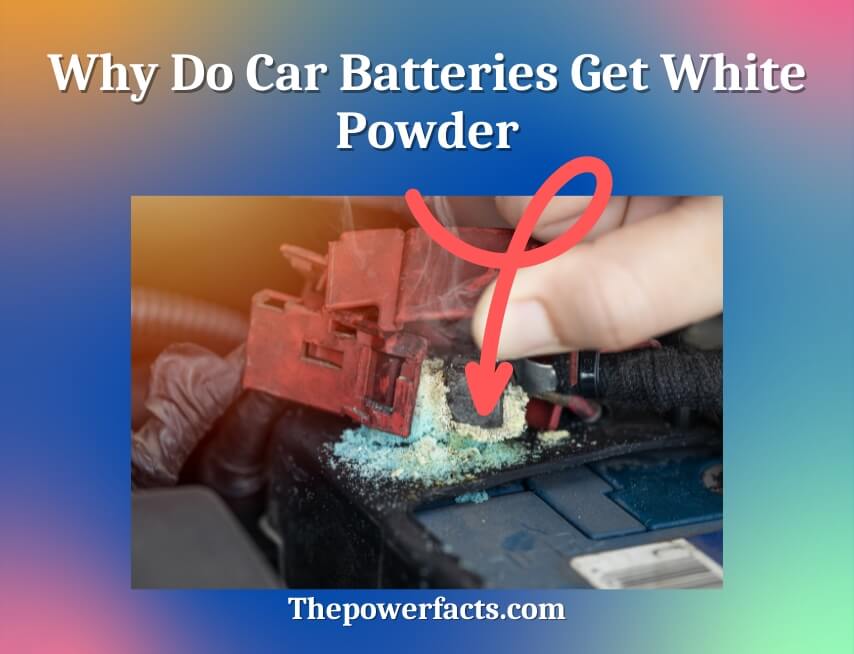When a car battery is working properly, the electrodes inside the battery are covered with a thin layer of a black substance called active material. This black substance is made up of lead dioxide and lead sulfate. These two materials are constantly reacting with each other to create electrical energy.
However, if the battery isn’t used for a while, the lead sulfate starts to build up on the electrodes. This build-up prevents the reaction from happening and eventually leads to a dead battery.

Car batteries usually have a white powdery substance on them. This is called corrosion and it happens when the battery terminals are exposed to air and moisture. The white powder is actually lead sulfate, which forms when the lead in the battery reacts with sulfuric acid.
Lead sulfate is not conductive, so it can prevent electrical current from flowing between the battery terminals. If left unchecked, corrosion can eventually damage the battery and cause it to fail. Most car batteries have some sort of protection against corrosion, such as a plastic cover over the terminals.
However, this protection can break down over time, especially if the battery is frequently exposed to wet conditions. That’s why it’s important to check your battery regularly for signs of corrosion and clean the terminals if necessary.
Is the White Powder from Batteries Toxic?
Yes, the white powder from batteries is toxic. The main component of this powder is lead, which is a heavy metal that can be harmful to human health if inhaled or ingested. Lead exposure can cause neurological problems, developmental delays, and even death.
Inhaling lead dust can also cause lung cancer. If you come into contact with this powder, it’s important to wash your hands and clothing thoroughly afterward to prevent accidental ingestion or inhalation.
How Do I Get Rid of White Battery Corrosion?

White battery corrosion, also known as battery acid, is a type of corrosion that can form on the terminals of batteries. This corrosion is caused by the reaction between lead and sulfuric acid in the battery. When this reaction occurs, it produces lead sulfate, which is a white powdery substance.
If you find white battery corrosion on your battery terminals, it’s important to clean it off as soon as possible. If left unchecked, this corrosion can cause serious damage to your battery and even your car’s electrical system. There are a few different ways to clean white battery corrosion off of your terminals.
One Way is to Use a Solution of Baking Soda and Water
Simply mix together equal parts of baking soda and water to form a paste. Then apply the paste to the corroded areas and let it sit for several minutes before wiping it away with a damp cloth.
Another Way to Clean White Battery Corrosion is by Using Vinegar
Simply pour some vinegar onto a rag and then rub it onto the corroded areas. The acid in the vinegar will break down the lead sulfate and make it easier to wipe away.
Note
Once you’ve removed all of the visible corrosion, be sure to rinse off the area with clean water to remove any residual chemicals. Then dry off the area completely before attaching your car’s battery terminals back onto the posts.
Credit: axleaddict.com
Why Is There White Powder on My Car Battery?
If you’ve ever found white powder on your car battery, you may have wondered what it is and why it’s there. The short answer is that the powder is most likely corrosion, and it’s a good idea to clean it off as soon as possible. Corrosion can occur when batteries are exposed to moisture or high humidity.
When corrosion builds up on the terminals of a battery, it can prevent electricity from flowing properly. This can lead to starting problems or even a complete loss of power. Fortunately, cleaning off corrosion is relatively easy.
You’ll need some basic supplies like baking soda, water, and vinegar. Once you have those, simply follow these steps:
1. Remove the battery terminal covers.
2. Mix together equal parts baking soda and water to form a paste.
3. Apply the paste to the corroded areas and let it sit for several minutes.
4. Rinse the area with clean water and dry with a cloth or towel.
5. If necessary, apply a thin layer of petroleum jelly or grease to help protect against future corrosion.
That’s all there is to it!
Is the White Powder from Batteries Dangerous?
Batteries are a common power source for many devices, but what about the white powder that is often seen on them? Is this powder dangerous?
The short answer is no, the white powder from batteries is not dangerous.
This powder is actually just zinc oxide, which is a harmless substance. However, it can be irritating if it comes into contact with your skin or eyes, so it’s best to avoid contact with it if possible.
If you do come into contact with zinc oxide, simply wash the area with soap and water.
You should also avoid inhaling the powder, as it can irritate your lungs. Overall, there is no need to worry about the white powder from batteries – it’s completely safe!
How to Clean White Powder from Battery
If your battery has white powder on it, chances are its corrosion. Corrosion is caused by a chemical reaction between the metal in the battery and either oxygen or water. It’s important to clean off this corrosion as soon as you see it because it can cause problems with your battery’s performance.
Here’s how to clean white powder from your battery:
1. First, make sure that your hands are clean and dry. You don’t want to introduce any new contaminants to the surface of the battery.
2. Next, using a soft cloth or brush, gently scrub at the corrosion. Be careful not to apply too much pressure, as you could damage the surface of the battery.
3. Once you’ve removed all of the visible corrosion, rinse the area with distilled water (you can find this at most grocery stores).
This will help remove any residual chemicals that could cause further corrosion down the road.
White Powder on Battery
If you’ve ever found a white powder on your battery, chances are its potassium carbonate. Potassium carbonate is a white salt that is insoluble in water. It’s often used as a drying agent or desiccant and can be found in some laundry detergents.
When mixed with water, potassium carbonate forms a viscous solution that can be used to clean metals. It’s also sometimes used as a food additive.
The car Won’t Start White Stuff on Battery
If your car won’t start and you notice white stuff on the battery, there’s a good chance the battery is frozen. This can happen in cold weather when the water inside the battery freezes and expands. A frozen battery won’t be able to provide enough power to start your car, so it’s important to thaw it out as soon as possible.
There are a few ways you can thaw out a frozen battery. One is to use a hairdryer or space heater, being careful not to melt any of the plastic parts around the battery. Another is to pour warm water over the battery until the ice melts.
Once the ice is melted, dry off any water that has pooled around the battery and try starting your car again. If your car still won’t start, there may be another problem unrelated to the battery. It’s always a good idea to take your car to a mechanic for a diagnosis if you’re having starting problems.
It’s important to know how to safely jump-start a modern car. Read the article for more information.
Why Does My Car Battery Keep Corroding?
Most car batteries are made of lead and acid, which will slowly corrode the battery over time. The main reason your car battery keeps corroding is because of the frequent starting and stopping of your engine. Every time you start your engine, a small amount of corrosion occurs on the battery terminals.
This is why it’s important to keep your car battery clean and free of corrosion. There are a few things you can do to prevent this from happening:
1) Check the Battery Terminals
Make sure the battery terminals are clean and free of any corrosion.
If they’re not, use a wire brush to clean them off.
2) Apply Dielectric Grease
This will help to prevent corrosion by creating a barrier between the metal surfaces.
3) Keep Your Car Clean
dirt and debris can accelerate the corrosion process, so make sure to keep your car clean both inside and out.
Does a Corroded Battery Need to Be Replaced?
If you have a car, it’s likely that you’ve experienced a dead battery at least once. When this happens, it’s usually because the battery has become corroded. Although it may seem like the logical thing to do is to simply replace the battery, this isn’t always necessary.
Corrosion occurs when the lead plates inside the battery are exposed to oxygen and moisture. This causes them to break down and form lead oxide. Lead oxide is a very conductive material, which means that it can cause problems with the electrical system in your car.
However, corrosion doesn’t necessarily mean that your battery needs to be replaced. In many cases, you can clean off the corrosion and extend the life of your battery. To do this, you’ll need some distilled water and baking soda.
First, remove the battery from your car and disconnect it from the terminals. Next, mix together equal parts of distilled water and baking soda until you have a thick paste. Apply this paste to the corroded areas of your battery using a toothbrush or other small brush.
Be sure to get into all of the nooks and crannies where corrosion might be hiding.
Blue Powder on Car Battery
If you’ve ever seen a blue powder on a car battery, you may have wondered what it is. The powder is actually manganese dioxide, and it’s used as an electrolyte in some types of batteries.
Manganese dioxide is a strong oxidizer, which means it can help to increase the voltage of a battery.
It’s also chemically stable, so it won’t break down over time like some other materials. That makes it ideal for use in batteries that need to provide a long-lasting charge.
The powder is usually mixed with water to form a paste, which is then applied to the battery’s electrodes.
When the paste dries, it forms a thin layer that helps to conduct electricity between the electrodes and the electrolyte solution.
If you see blue powder on your car battery, don’t be alarmed – it’s just manganese dioxide doing its job!
Verdict
There are a few reasons your car battery may have white powder on it. It could be from corrosion, which is usually caused by exposure to moisture or chemicals. Alternatively, the powder could be baking soda, which is sometimes used to clean batteries.
If you’re concerned about the white powder on your battery, you can take it to a mechanic or auto parts store for further inspection.